One-Moment Meditation® Day 10: The After-the-Emergency Minute

Photo: Goodshot/Thinkstock
Today, we are going to look at several different kinds of stress and how these can affect you. I'll also give you a version of the Portable Minute that can help you recover from stress quickly—insuring that you are not carrying the effects of that stress around with you for the rest of the day (or the rest of your life).
The word "stress" is sometimes used in a positive way. This is the so-called "good stress"—when you are choosing to do something challenging, like learning a new language or pushing yourself harder at the gym. This stress can be stimulating, energizing and very good for you. This is why I prefer to call it "stretch" rather than "stress."Then there is acute stress, which is when you perceive a sudden threat or insult, and your body prepares you for immediate action. It releases stress hormones, shuts down digestion and increases your heart rate, blood glucose levels and oxygen delivery to the brain. It also quickens your breathing and tightens your muscles, making you ready to spring.
This is sometimes called the fight-or-flight response—and it was very useful when we lived in the wild. The problem is that it's not so easy to fight or flee these days.
For example, when the bus pulls away from the curb—just as you arrive at the bus stop—you can't hit it with a club. When the insurance company hikes your premium, there's nowhere to run. In situations like these, you don't get to discharge the stress reaction very easily.
And when stress is chronic (e.g., when you're worried about losing your job, or you're coping with an ongoing illness or an abusive relationship), the continual release of stress hormones can be a serious health risk. Chronic stress has been implicated in type 2 diabetes, hypertension, compromised immune systems and putting on extra weight, as well as concentration problems, mood swings and depression.
In addition to the fight or flight response, there is a third response to stress, sometimes known as the freeze response, or "playing dead." This is no more helpful than fighting or fleeing. The freeze response might happen when we are not fully conscious of how stressful the situation is, when we are inhibited from reacting (perhaps out of fear) or when we just can't handle the stress any more. With the freeze response, we shut down emotionally, becoming numb or frozen. Gradually, over many years, we may become unable to feel much of anything—even pleasure or joy.
However, there is something you can do in response to stress that doesn't involve fighting, fleeing or freezing. You can do an After-the-Emergency Minute. This is a Portable Minute that you do as soon as possible after experiencing something stressful. The purpose of the After-the-Emergency Minute is to help make sure you don't get stuck in any stress-related pattern.
With an After-the-Emergency Minute, you will feel the effects of the shock on your body start to dissipate—your muscles relax, your shoulders drop, your breathing returns to a normal rate. You should start to feel less jumpy and more connected to a more peaceful and trusting you.
The After-the-Emergency Minute may not be the easiest Minute to do, but it's certainly worth trying. And, as with the Emergency Minute, you may need to do several of them in a row, one at a time.
On occasion, the After-the-Emergency Minute might make you feel a bit more emotional, because it's giving you some space to experience your authentic reactions to the situation. It's as if you're thawing out, and that's perfectly okay. The most important thing is just to release whatever emotional and physical reaction the stress triggered. By releasing that reaction, you are rejoining with the flow of life.
For the next 24 hours, I'd like you to try an After-the-Emergency Minute after anything stressful happens to you—whether it's a major stress or just a minor one, like dropping a glass, stubbing your toe or being on the receiving end of someone else's bad mood.
If that's not possible, at least take a moment to note that something stressful did happen and that you might have benefited from taking a Minute. Simply being aware that you have experienced some stress is a big step toward letting go of it.
It would be nice, someday, if all emergency personnel—nurses, doctors, rescue workers, paramedics, police, firefighters—carried an After-the-Emergency Minute with them, as part of their emergency equipment.
Because they don't, you may have to be ready to administer one when needed. So I suggest you practice a Portable Minute from time to time, when it isn't needed. Just so you're ready.
Get started with the Portable Minute now
Martin Boroson is a playful, practical new voice in the next wave of meditation teachers. Author of One-Moment Meditation: Stillness for People on the Go, he lectures on the benefits of a meditative mind for decision-making and leadership. Marty studied philosophy at Yale, earned an MBA from the Yale School of Management and is a formal student of Zen. Visit his website for One-Moment Meditation® help and resources, tweet him at @takeamoment or find him on Facebook.
Find out more about the 30-Day One-Moment Meditation course
Don't miss a moment! Go to the archive page
Did you try the After-the-Emergency Minute?Did you take time to recognize your stress today? Let us know how it's going—leave your comments and questions below!



